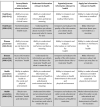Validity and reliability of the Musicians' Health Literacy Questionnaire, MHL-Q19
- PMID: 36211877
- PMCID: PMC9541534
- DOI: 10.3389/fpsyg.2022.886815
Validity and reliability of the Musicians' Health Literacy Questionnaire, MHL-Q19
Abstract
High prevalence of musicians' physical and mental performance-related health issues (PRHI) has been demonstrated over the last 30 years. To address this, health promotion strategies have been implemented at some post-secondary music institutions around the world, yet the high prevalence of PRHI has persisted. In 2018, an international group of researchers formed the Musicians' Health Literacy Consortium to determine how best to decrease PRHI, and to examine the relationship between PRHI and health literacy. An outcome of the Consortium was the development of a new health literacy tool for musicians, the MHL-Q19, which drew from the theoretical framework of the European health literacy suite of tools, HLS-EU. The aim of the current study was to evaluate the validity and reliability of the MHL-Q19. Participants completed a battery of questionnaires, including the HLS-EU-Q16 for the assessment of general health literacy; the Musculoskeletal Pain Intensity and Interference Questionnaire for Musicians (MPIIQM); the RAND-12 quality of life questionnaire; and the General Self-Efficacy scale (GSE). We hypothesized that the MHL-Q19 would have a weak correlation with the HLS-EU-Q16; moderate correlation with the physical component scale and weak correlation with the mental component scale of the RAND-12; moderate correlation with the GSE; and finally, moderate correlation with pain interference and weak correlation with pain intensity of the MPIIQM. A total of 549 post-secondary music students from six English-speaking countries completed the battery of questionnaires, and 328 of these participants provided valid responses to the MHL-Q19 alone 2 weeks later. The tool showed acceptable internal consistency and test-retest reliability. Three of our hypotheses were supported, although the strength of the correlations varied from what we had predicted. The fourth hypothesis was not supported; our findings indicate that lower health literacy scores were weakly related to higher MPIIQM pain intensity and interference scores. The results of this study support the notion that musicians' health literacy is a distinct construct that cannot be fully evaluated with existing health literacy tools. Given that this is a new instrument, the evidence presented is positive and promising. Further studies will be needed to refine the tool.
Keywords: health literacy; musicians’ health; occupational health; psychometrics; reliability; validity.
Copyright © 2022 Guptill, Slade, Baadjou, Roduta Roberts, de Lisle, Ginsborg, Rennie-Salonen, Ackermann, Visentin and Wijsman.
Conflict of interest statement
The authors declare that the research was conducted in the absence of any commercial or financial relationships that could be construed as a potential conflict of interest.
Figures


References
-
- Abubakar A., Dimitrova R., Adams B., Jordanov V., Stefenel D. (2013). Procedures for translating and evaluating equivalence of questionnaires for use in cross-cultural studies. Bull. Transilv. Univ. Braşov. Ser. VII Soc. Sci. Law 6:55.
Publication types
LinkOut - more resources
Full Text Sources

